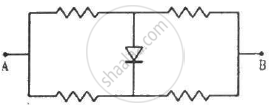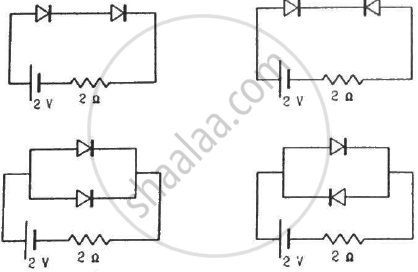Advertisements
Advertisements
प्रश्न
In a p-n junction diode, the current I can be expressed as
I = `"I"_0 exp ("eV"/(2"k"_"BT") - 1)`
where I0 is called the reverse saturation current, V is the voltage across the diode and is positive for forward bias and negative for reverse bias, and I is the current through the diode, kBis the Boltzmann constant (8.6×10−5 eV/K) and T is the absolute temperature. If for a given diode I0 = 5 × 10−12 A and T = 300 K, then
(a) What will be the forward current at a forward voltage of 0.6 V?
(b) What will be the increase in the current if the voltage across the diode is increased to 0.7 V?
(c) What is the dynamic resistance?
(d) What will be the current if reverse bias voltage changes from 1 V to 2 V?
उत्तर
a) In a p-n junction diode, the expression for current is given as:
I = `"I"_0 exp("eV"/(2"k"_"B" "T") - 1)`
Where,
I0 = Reverse saturation current = 5 × 10−12 A
T = Absolute temperature = 300 K
kB = Boltzmann constant = 8.6 × 10−5 eV/K = 1.376 × 10−23 J K−1
V = Voltage across the diode
(a) Forward voltage, V = 0.6 V
= `5 xx 10^(-12)[exp ((1.6xx 10^(-19) xx 0.6)/(1.376 xx 10^(-23) xx 300))-1]`
∴ Current, I
`= 5 xx 10^(-12) xx exp [22.36] = 0.0256 A`
Therefore, the forward current is about 0.0256 A.
(b) For forward voltage, V’ = 0.7 V, we can write:
I' =`5 xx 10^(-12) [exp ((1.6 xx 10^(-19) xx 0.7)/(1.376 xx 10^(-23) xx 300)) - 1]`
`= 5 xx 10^(-12) xx exp [26.25] = 1.257` A
Hence, the increase in current, ΔI = I' − I
= 1.257 − 0.0256 = 1.23 A
(c) Dynamic resistance = `"Change in voltage"/"Change in Current"`
`= (0.7 - 0.6)/1.23 = 0.1/1.23 = 0.081 "Ω"`
(d) If the reverse bias voltage changes from 1 V to 2 V, then the current (I) will almost remain equal to I0 in both cases. Therefore, the dynamic resistance in the reverse bias will be infinite.
APPEARS IN
संबंधित प्रश्न
In an unbiased p-n junction, holes diffuse from the p-region to n-region because ______.
Write the two processes that take place in the formation of a p-n junction.
A zener diode is fabricated by heavily doping both p- and n- sides of the junction. Explain, why?
Explain briefly with the help of necessary diagrams, the forward biasing of a p-n junction diode. Also draw characteristic curves.
A student wants to use two p-n junction diodes to convert alternating current into direct current. Draw the labelled circuit diagram she would use and explain how it works.
Explain, with the help of a circuit diagram, the working of a photo-diode. Write briefly how it is used to detect the optical signals.
Mention the important considerations required while fabricating a p-n junction diode to be used as a Light Emitting Diode (LED). What should be the order of band gap of an LED if it is required to emit light in the visible range?
The drift current in a p-n junction is
Diffusion current in a p-n junction is greater than the drift current in magnitude
In a p-n junction,
(a) new holes and conduction electrons are produced continuously throughout the material
(b) new holes and conduction electrons are produced continuously throughout the material except in the depletion region
(c) holes and conduction electrons recombine continuously throughout the material
(d) holes and conduction electrons recombine continuously throughout the material except in the depletion region.
In a p-n junction, a potential barrier of 250 meV exists across the junction. A hole with a kinetic energy of 300 meV approaches the junction. Find the kinetic energy of the hole when it crosses the junction if the hole approached the junction (a) from the p-side and (b) from the n-side.
Each of the resistance shown in figure has a value of 20 Ω. Find the equivalent resistance between A and B. Does it depend on whether the point A or B is at higher potential?

Find the currents through the resistance in the circuits shown in figure.

(Assume that the resistance of each diode is zero in forward bias and is infinity in reverse bias.)
When the base current in a transistor is changed from 30µA to 80µA, the collector current is changed from 1.0 mA to 3.5 mA. Find the current gain β.
A load resistor of 2kΩ is connected in the collector branch of an amplifier circuit using a transistor in common-emitter mode. The current gain β = 50. The input resistance of the transistor is 0.50 kΩ. If the input current is changed by 50µA. (a) by what amount does the output voltage change, (b) by what amount does the input voltage change and (c) what is the power gain?
Answer in detail.
Discuss the effect of external voltage on the width of depletion region of a p-n junction.
The depletion layer in the p-n junction diode is caused by ______.
The formation of the depletion region in a p-n junction diode is due to ______.
During the formation of a p-n junction ______.
